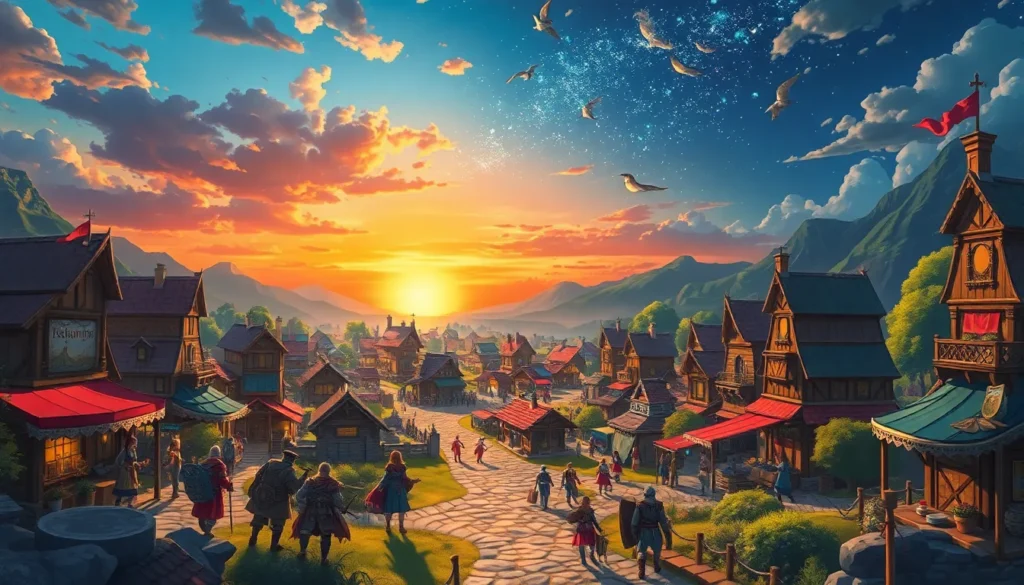Table of Contents
ToggleImagine wandering through a vibrant fantasy world where the sun rises and sets, casting shadows that dance across the landscape. The day-night cycle in RPGs isn’t just a pretty visual; it’s a game-changer that adds depth and realism to the player’s experience. Whether it’s the thrill of battling monsters under the moonlight or the cozy charm of a bustling village at dawn, the rhythm of day and night shapes adventures in unexpected ways.
In this article, we’ll dive into the enchanting mechanics of the RPG day-night cycle. From strategic gameplay changes to immersive storytelling, this cycle offers much more than just a backdrop. So buckle up as we explore how these shifting hours can turn an ordinary quest into an unforgettable journey. Who knew that a simple rotation of the earth could lead to so much excitement?
Overview of RPG Day Night Cycle
The day-night cycle in RPGs plays a crucial role in shaping gameplay dynamics. This cycle influences character behavior, NPC (non-player character) interactions, and environmental conditions. During daytime, players may encounter formidable enemies and engaging quests that require strategic planning. Nighttime brings its own challenges, often introducing stealth mechanics and different creatures.
Environmental changes enhance immersion. Many RPGs feature shifting visuals, from bright skies to shadowy landscapes. These transitions not only create a sense of time passing but also alter how players approach challenges. For example, an area that feels safe during the day might become perilous at night.
Quests often reflect this dynamic system. Certain missions may only become available after dark, compelling players to wait for the right moment. Events tied to specific times encourage exploration and experimentation, further enriching the narrative.
The day-night cycle enhances storytelling. Characters may have different dialogues or quests based on the time of day. This feature promotes deeper engagement, as players feel their choices resonate within the game’s world.
In combat scenarios, time affects strategies. Players might prefer to launch attacks during the day for visibility, while nighttime may favor ambush tactics. This provides a strategic layer that keeps gameplay fresh and challenging.
Many RPGs also incorporate weather alongside the day-night cycle. Rain or fog can impact visibility and movement, altering combat and exploration dynamics. These factors combine to create a layered experience, where time shapes player decisions, story arcs, and overall game enjoyment.
Importance of Day Night Cycle in RPGs

The day-night cycle significantly influences the gameplay experience in RPGs. This dynamic aspect enriches player engagement and broadens the narrative landscape.
Enhancing Immersion
Immersion significantly improves when a day-night cycle operates in RPGs. Players experience visual changes, with bright daylight transforming into dim nighttime shadows. These environmental shifts create a sense of realism, making virtual worlds feel alive. Dynamic weather patterns, such as rain or fog, contribute to this effect, altering visual aesthetics and atmosphere. Players often find themselves adjusting their strategies based on varying lighting conditions. Nighttime introduces thrilling challenges, such as stealth segments and unique creatures, which further engross participants in gameplay. Rich soundscapes also evolve with time, deepening the connection between players and their environments.
Impact on Gameplay Mechanics
Gameplay mechanics undergo notable transformations due to the day-night cycle. Time influences combat strategies, with visibility becoming a critical factor during the day. Players may opt for aggressive tactics under sunlight while employing cautious approaches at night. NPC availability frequently shifts according to day and night, presenting different quests and dialogue options based on the time. Certain in-game events, such as festivals or raids, may occur exclusively during specific hours, replacing routine gameplay with fresh opportunities. Exploration becomes more rewarding as players discover hidden secrets that emerge only after dark. Ultimately, this cycle compels players to adapt continuously to changing conditions, ensuring a dynamic and engaging experience.
Examples of RPGs with Notable Day Night Cycles
Several RPGs feature dynamic day-night cycles that significantly enhance gameplay experiences. These games utilize the passage of time to influence in-game events and player interactions.
The Elder Scrolls Series
The Elder Scrolls series stands out for its immersive open-world environments. Daytime presents players with bustling towns and various quests, while nighttime introduces unique challenges. Creatures such as vampires emerge during dark hours, changing combat dynamics. NPC dialogues often shift based on the time, offering different quests and lore. Players must adapt their strategies, leveraging the cycle for exploration and character development. The visually striking transition from day to night deepens engagement with the game world.
The Witcher Series
The Witcher series masterfully integrates its day-night cycle into the narrative. With sunlight, players can encounter a diverse range of characters and quests marked by vibrant landscapes. At night, darker elements of the game emerge. Monsters like ghouls and wraiths become active, posing threats to unprepared players. The game’s quests often depend on the time of day, with some only available in darkness. This structure compels players to plan their journeys carefully, enhancing the overall storytelling experience.
Animal Crossing Series
Animal Crossing series portrays a more relaxed approach to the day-night cycle. Players experience in-game time that mirrors real-world time, fostering a unique connection with the game. Each hour reveals different events, activities, and critters available for interaction. During the day, players can engage in various tasks and interactions with animal villagers. At night, serene environments shift focus to nocturnal critters and special events like fishing tournaments. This seamless transition creates a rewarding rhythm for players, encouraging daily engagement with the game world.
Game Design Considerations
Developing a day-night cycle in RPGs involves several key design considerations. These factors directly influence player interaction and overall game immersion.
Balancing Time Progression
Establishing a balanced time progression system enhances gameplay. Designers can set fixed durations for day and night, ensuring predictability for players. Including gradual transitions between these phases adds realism. Variability in time length creates dynamic experiences; for example, longer nights may increase player tension and challenge. Aligning time cycles with gameplay aspects encourages players to adjust strategies accordingly. Furthermore, integrating quick time events during transitions can enhance excitement and engagement.
Player Engagement and Activities
Encouraging player engagement relies significantly on the activities available throughout the day and night. During daylight, designers can implement quests that require social interaction and combat with standard enemies. Nighttime activities may focus on stealth missions or unique challenges like hunting rare monsters. NPCs can offer different dialogues and rewards based on the time, fostering curiosity. Crafting events tied to specific times also promotes exploration. By enhancing the variety of tasks available at different hours, players remain invested and eager to witness the unfolding narrative.
The day-night cycle in RPGs is more than just a visual aesthetic; it’s a vital component that enriches gameplay and storytelling. By introducing variations in challenges and opportunities based on time, players experience a deeper level of immersion. This dynamic system encourages strategic thinking and exploration, transforming each quest into a unique adventure.
As players navigate through the shifting landscapes of day and night, they encounter new creatures and quests that keep the gameplay fresh and engaging. The thoughtful design of these cycles not only enhances player enjoyment but also fosters a connection to the game world. Ultimately, the day-night cycle is a powerful tool that elevates the RPG experience, making every moment in the game feel significant.







